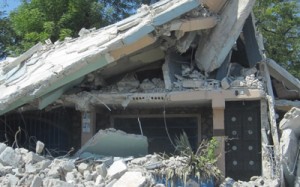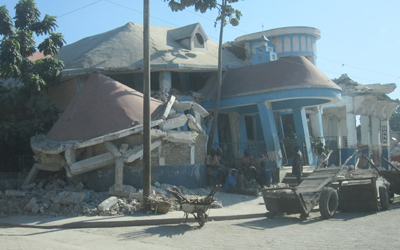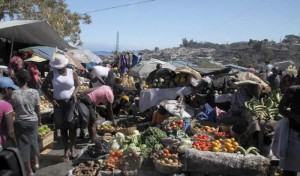Written by Ann Petersen, HFH board member and part of the March medical team to Terre Blanche.
I arrived in Haiti just seven weeks after the 7.0 earthquake of January 12. After seeing the devastation on the news and reading stories I wasn’t sure what to expect. As our plane made its approach into Port-au-Prince everyone was peering out the windows to get a first glimpse of the area that had been hit by the massive earthquake. A hint of the destruction could be seen as piles of rubble came into view. We soon touched down…
 As we drove along the outskirts of Port-au-Prince I didn’t see widespread areas of collapsed buildings. What I did notice was the usual hustle and bustle of life on the streets but with a changed backdrop of broken homes and buildings. Homes that appeared intact have tents or tarps outside where people are living – people are afraid to sleep in their homes or spend any time inside buildings. We passed several vacant lots full of tents or tarps and outside the city we saw a hillside filled with shelters built of blue tarps and plastic hung on stick frames. As the rainy season approaches these temporary shelters are inadequate and present health issues…
As we drove along the outskirts of Port-au-Prince I didn’t see widespread areas of collapsed buildings. What I did notice was the usual hustle and bustle of life on the streets but with a changed backdrop of broken homes and buildings. Homes that appeared intact have tents or tarps outside where people are living – people are afraid to sleep in their homes or spend any time inside buildings. We passed several vacant lots full of tents or tarps and outside the city we saw a hillside filled with shelters built of blue tarps and plastic hung on stick frames. As the rainy season approaches these temporary shelters are inadequate and present health issues…
 We arrived in Terre Blanche after dark and were warmly welcomed with singing and a prayer of thanksgiving by some of our Haitian co-workers. Our medical team had been scheduled for over a year and we worked alongside the Haitian clinic staff to meet the needs of people coming through the clinic. The earthquake was heard and felt throughout the country of Haiti but in our area there was no loss of life and the buildings are intact although some have cracks now. Like in PAP, people live with fear about future earthquakes. This area has not had a harvest for two years due to the devastating hurricanes of 2008 and then droughts that dried up later crops. The riverbed has only a trickle of water, barely enough to wash clothes. Many households have doubled in size as displaced people have moved out of the earthquake-affected areas. In a community that is already feeling the lack of food and water, more people have caused additional strain. Because of the generosity of churches and individuals, we were able to give beans and rice to every patient coming through the clinic – that was over 1,100 people.
We arrived in Terre Blanche after dark and were warmly welcomed with singing and a prayer of thanksgiving by some of our Haitian co-workers. Our medical team had been scheduled for over a year and we worked alongside the Haitian clinic staff to meet the needs of people coming through the clinic. The earthquake was heard and felt throughout the country of Haiti but in our area there was no loss of life and the buildings are intact although some have cracks now. Like in PAP, people live with fear about future earthquakes. This area has not had a harvest for two years due to the devastating hurricanes of 2008 and then droughts that dried up later crops. The riverbed has only a trickle of water, barely enough to wash clothes. Many households have doubled in size as displaced people have moved out of the earthquake-affected areas. In a community that is already feeling the lack of food and water, more people have caused additional strain. Because of the generosity of churches and individuals, we were able to give beans and rice to every patient coming through the clinic – that was over 1,100 people.
 Clinic of Hope stories: Healthy newborn baby boy; severe leg injury from a motorcycle accident; advanced cancer diagnosis given to several different patients; beans and rice given to every patient; waking in the morning to hymns of praise being sung by those in the clinic waiting area; young woman suffering depression after her five year old son and 21-year-old sister died in the earthquake; people receiving prayer as well as medicine; smiles of children as they receive lollipops at the doctor tables; happiness that we were able to see every waiting patient each day; patients spending the night in the observation room; minor surgeries done; malnourished children receiving high nutrition peanut butter supplement on the Medika Mamba program; and the list goes on.
Clinic of Hope stories: Healthy newborn baby boy; severe leg injury from a motorcycle accident; advanced cancer diagnosis given to several different patients; beans and rice given to every patient; waking in the morning to hymns of praise being sung by those in the clinic waiting area; young woman suffering depression after her five year old son and 21-year-old sister died in the earthquake; people receiving prayer as well as medicine; smiles of children as they receive lollipops at the doctor tables; happiness that we were able to see every waiting patient each day; patients spending the night in the observation room; minor surgeries done; malnourished children receiving high nutrition peanut butter supplement on the Medika Mamba program; and the list goes on.
 Terre Blanche School: There are 850 students registered at the Terre Blanche school in grades pre-K through 9th grade. It was wonderful to see how much these students value their education and love and respect their teachers. Students receive a meal each day, a generous serving of rice and beans with a sauce. There were four educators on our team and we were able to spend time in the primary and secondary classrooms. We met each of the teachers, talked with students and then had the joy of going into the 9th grade English class to have English conversations with small groups of students. Students start learning French in pre-K with English and Spanish added in the secondary school.
Terre Blanche School: There are 850 students registered at the Terre Blanche school in grades pre-K through 9th grade. It was wonderful to see how much these students value their education and love and respect their teachers. Students receive a meal each day, a generous serving of rice and beans with a sauce. There were four educators on our team and we were able to spend time in the primary and secondary classrooms. We met each of the teachers, talked with students and then had the joy of going into the 9th grade English class to have English conversations with small groups of students. Students start learning French in pre-K with English and Spanish added in the secondary school.
It was a blessing to tell people we met that Haiti and her people are not alone or forgotten – that people back home care and are praying for them. I told them that we have seen and heard news reports of prayer gatherings, hymn singing, church services and people’s individual faith – it is a testimony to the rest of the world. I continue to be impressed by the strength, courage and faith of the Haitian people – I see hope. There will continue to be difficult days ahead for the people of Haiti as they deal with the hardships of life and the results of the earthquake. Please remember Haiti and her people and the many needs that exist.
Dr. Joe and Linda Markee were featured today in an article in The Columbian (Vancouver, Wash.) newspaper about their work in Haiti following the January 12 earthquake.
Joe and Linda, board members with Haiti Foundation of Hope, traveled to Haiti within days of the earthquake as part of a disaster relief team with Medical Teams International. They worked in Port-au-Prince and later in Terre Blanche, providing medical care and administrative assistance.
Couple lend Haiti a healing hand (The Columbian):
Linda and Dr. Joe Markee have learned a lot about the damage an earthquake can cause.
The Vancouver couple just spent two months in Haiti as medical volunteers. They saw how falling bricks and collapsing concrete can crush flesh and shatter bones, but that was no surprise to the Markees.
What they didn’t know was how something that sounds like an earthquake can create a panic that produces more injuries.
Yes, an earthquake has a distinctive sound, the Markees were assured by survivors.
“There were stories about how you could hear the ground roar,” said Joe, a retired obstetrician-gynecologist. “It’s the earth moving.”
“The noise was described as a loud truck coming down the road,” said Linda, a nurse.
Sarah Case, a member of the medical team currently in Haiti, is blogging about her experiences. Here are some of her reflections:
It was hard to know what to expect as the airplane descended into Port au Prince. Such a familiar experience, and yet after seven weeks of continuous media coverage depicting a Haiti split apart at the seams, I no longer had a frame of reference…
We wound our way through one side of the capital city, noticing how much was the same: roadside markets with trinkets for sale, barefoot children, cinder block houses with tattered metal roofs, colorful tap-taps laden with one too many passengers. And then, in the midst of what would seem to be an average Port au Prince street, the remnants of a two story building, pancaked and abandoned. Or an ad hoc encampment with a few dozen tents and a sign posted at the entrance asking for food, water, medicine. In the midst of ongoing city life were these severe reminders of the destruction that is around every corner. Our route took us through the “better” side of Port au Prince, and we’ve had no opportunity to see what the worst truly looks like.
Farther out into the countryside in barren, hilly fields we saw hundreds of tents spread out for acres and acres. Along the national highway, countless truckloads of rubble, just piled mound after mound after mound. What does one do with the remains of a city? What can be done with an ocean of crumbled concrete?
Read the latest Haiti Foundation of Hope news in our March newsletter:
The rumble and roar of the earthquake was felt and heard in Terre Blanche, a village about 100 miles north of Port-au- Prince, however the buildings remained intact and no one was injured. But the emotional impact of the January 12 quake was very real and continues to be felt every day… Read More.
Dr. Steve Sethi, HFH board member, reports on his recent trip to Haiti:
 The situation all around Haiti is so incredible that it’s hard to express in words. The sheer enormity of the destruction can hardly be conveyed adequately by words or pictures, and the emotional trauma is even more hidden. There are fallen buildings for miles, thousands of people living in the open, and many Haitians just struggling to keep their families alive. I was privileged to contribute a tiny fraction to the work many are doing to help relieve and reconstruct.
The situation all around Haiti is so incredible that it’s hard to express in words. The sheer enormity of the destruction can hardly be conveyed adequately by words or pictures, and the emotional trauma is even more hidden. There are fallen buildings for miles, thousands of people living in the open, and many Haitians just struggling to keep their families alive. I was privileged to contribute a tiny fraction to the work many are doing to help relieve and reconstruct.
For a week, I worked with a public health specialist with our partner organization MTI, interviewing people in earthquake affected villages around Leogane to find out their longer term needs. We did hear that health care is very hard to find, but most people are just struggling to get enough water or find a usable latrine. The early recovery needs will certainly include the basic necessities of water and sanitation.
Beyond the physical needs, the emotional catastrophe is widespread. Nearly every person I saw, either in the villages or in clinics, talked about how fearful they were. They talked about being easily startled, quickly forgetful, preoccupied by a feeling of shaking, and a sense that they just weren’t the same person anymore. They are worried about their families and how to take care of them. They are going to need the support of churches, counselors, and our prayers.
The second week was spent with our partners in Terre Blanche. While the physical destruction can’t be seen after 20 miles out of the capital, the impact of the earthquake is unmistakable. I spent a day interviewing patients at our clinic and visiting homes in the village, and found that earthquake survivors are in every community, usually doubling the household sizes. Just as in Port-au-Prince, people everywhere are traumatized.
A Haitian friend at the clinic told me that 99 percent of the country has been affected — either a family member or a friend or a distant relative was killed. Even more than 100 miles away from the earthquake, he carries the burden of thinking his family might die at any moment. But he also sees this as a wake up call from God — an indication of his power and a call to turn to him. It is true that things have changed — Carnival (with the loud ra-ra bands and dangerous alcoholic crowds) was cancelled and instead there was a three-day period of prayer. Along the roads in every town, whole churches went out marching, singing hymns and praying.
It was this commitment to prayer that gave me hope. In the midst of tragedy, people are praising God! Could I have that kind of faith? Our friends in Terre Blanche, the volunteers we’ve trained in health promotion, are still eager and active, visiting homes to teach families how to prevent diarrhea and referring sick children to the clinic. These brothers and sisters are a testament to enduring faith and, as Pastor Delamy says, a personification of grace. And people here at home are giving hope as well, by praying and caring about Haiti. Thank you.

Steve and other workers in Haiti.

Collapsed house in Leogane.

Church members singing on a street corner.
 Haiti Foundation of Hope board member Linda Markee, who is in Port-au-Prince with her husband, Dr. Joe Markee, sent this update on the earthquake recovery:
Haiti Foundation of Hope board member Linda Markee, who is in Port-au-Prince with her husband, Dr. Joe Markee, sent this update on the earthquake recovery:
Port-au-Prince is returning to life. The banks are open, there are lots of fresh fruits and vegetables in the local outdoor markets, fuel is once again available, although the price is high. Along with the availability of fuel there are many traffic jams. People are beginning to clean up rubble.
I did go to the University of Miami Hospital, which has been set up by the airport. It is an amazing operation. One of the tents probably had over 100 patients on cots. Lots of people recovering from surgery. I did hear, however, that it is now almost too late to set fractures as the wounds are now old, so after a while people will need to have a different type of surgery.
Lots of people are talking about building a “New Haiti.” Once again I see hope in the eyes of Haitians, which to me, personally, is amazing. Joe and I also experienced this sense of hope as we worshipped with the Haitians last Sunday.
Joe and Linda plan early next week to go to Terre Blanche, a village north of Port-au-Prince, where Haiti Foundation of Hope has ongoing programs including a medical clinic. Another foundation board member, Dr. Steve Sethi, is also in Haiti.
Every person living in Port-au-Prince has a story to tell about how the earthquake has impacted them.
One of those people is Claudine, a Haitian pharmacist working in the capital city alongside disaster relief volunteers. In a city now covered in dust and debris, Claudine arrives at work looking clean and lovely, with a well-pressed lab coat. But beneath the exterior is a life filled with difficulties. Like so many people, Claudine’s house collapsed in the earthquake and she now sleeps on the streets, where they is a lot of fear of robbery and assault, and where no one gets much rest.
Claudine is just one of millions of people in Haiti whose lives have been changed by this recent disaster. It’s with your support that we are working to help the people in Haiti. Thank you.
The disaster relief team sent by Medical Teams International and which includes two board members from Haiti Foundation of Hope has made its way to Port-au-Prince to help in the aftermath of Tuesday’s earthquake. The team flew into Cap-Haitien at the north end of Haiti and took part of two days to drive to the capital, where they began work at Kings Hospital, located about 20 minutes from the airport.

 Instagram Feed
Instagram Feed